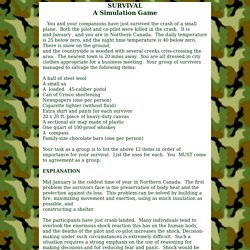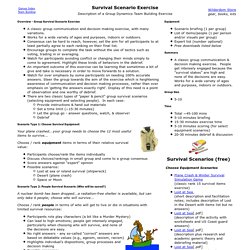

SURVIVAL A Simulation Game. 1.

Cigarette lighter (without fluid) The gravest danger facing the group is exposure to cold. The greatest need is for a source of warmth and the second greatest need is for signaling devices. This makes building a fire the first order of business. Without matches, something is needed to produce sparks, and even without fluid, a cigarette lighter can do that.
Survival Exercise Scenarios - Description of a Group Dynamics Team Building Exercise. Overview - Group Survival Scenario Exercise A classic group communication and decision making exercise, with many variations.

Works for a wide variety of ages and purposes, indoors or outdoors. Consensus can be hard to reach, however, set the aim for all participants to at least partially agree to each ranking on their final list. Encourage groups to complete the task without the use of tactics such as voting, trading in or averaging. Watch for participants avoiding conflict or changing their minds simply to come to agreement. Scenario Type 1: Choose Survival Equipment Your plane crashed...your group needs to choose the 12 most useful items to survive... Choose / rank equipment items in terms of their relative survival value: Participants choose/rank the items individually Discuss choices/rankings in small group and come to a group consensus Score answers against "expert" opinion Possible scenarios: Lost at sea or island survival (shipwreck) Desert (plane crash) Space or Moon.
Survive Nature - Techniques for Surviving on a Deserted Island. Building a fire not only keeps you warm, but it will help to signal any rescue planes that are flying overhead. Building The Structure: Step 1: Gather dry tinder, twigs, and branches of various sizes. Step 2: Using the smaller twigs, create a tepee shape with tinder placed in the center. Lighting The Fire: If you have glasses, binoculars, or a camera, use the lens to concentrate the rays on the tinder to ignite it. Then blow when it starts smoking. Otherwise, your best alternative is to use the "Fire-Plow" method. The Fire-Plow Method Step 1: Find a soft wood and cut a groove in its base. 4h.uwex.edu/pubs/showdoc.cfm?documentid=19788.
Survival Zone: Ocean: Food & Water. Make Fire Fast. DIY: Emergency Desalination still. Survival Guide on a Deserted Island. When you find yourself stranded on a deserted island, whether as a result of a shipwreck or getting separated from a group, survival is a crucial consideration.

Even if you are not an experienced outdoorsman, you can take basic steps that will help you stay alive until help arrives. Water Finding fresh, drinkable water should be a top priority upon discovering that you are stranded. If the weather is very cold or very wet, build a shelter first. According to Scientific American, drinking water will help you survive longer even if you are eating little to no food.
Shelter Look around the island for a good shelter spot; if you have found fresh water, put your shelter within easy walking distance. Food Food is an important consideration on a deserted island, but you must be careful about what you ingest. Rescue Build a big fire on the highest shore point; if you know where the shipping lanes pass, put your fire in the most visible spot. Lostways.org Many Try To Imitate Us With Knock-Offs. Islands Live Teacher's Guide - Island Survival.
Island Survival Summary In this activity, students will participate in a simulation of life on a deserted island. They will be challenged to use their critical thinking skills and knowledge of oceans and islands to “survive” and ultimately return to safety. Objectives At the conclusion of the lesson, students will be able to: understand options for meeting basic human needs and develop a plan for meeting such needs work cooperatively with classmates to solve real-world problems relating to survival Time: 3–5 periods Background This activity consists of a simulation of survival on a deserted island.
It is important that you teach some basic survival facts, such as the role of water, shelter, warmth, and food in increasing a person’s chances for survival. Shelter and warmth are also key for survival. Food is another key element in survival, as it directly relates to a person’s state of health and energy. Teacher's Notes This activity requires some advance preparation.